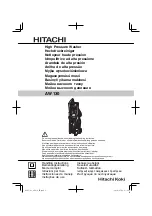
Precautions
•
Never fill cooker more than half. If frothing occurs, reduce
quantity by a further 10%. Legumes expand when cooked and
absorb water. Do not reduce water quantity below 1
1
/
2
cups.
•
Measure legumes. Pick over to remove stones, dirt and shriveled,
broken pieces and wash before cooking. To wash: place legumes
in a bowl. Cover with water and agitate gently. Remove and
discard floating pieces. Tip bowl to one side to drain off water,
keeping one hand on the edge of the bowl to prevent legumes
spilling. Repeat several times.
•
Most varieties of beans yield about 2
1
/
2
cups cooked beans for every
1 cup dry beans.
Soaking Legumes
You may or may not soak most legumes before pressure cooking.
Soaked legumes cook more evenly, more quickly and may taste better.
Soaking legumes and then discarding the soaking water can reduce the
water soluble complex sugars which may cause the discomfort some
people experience digesting legumes. If you soak legumes, adding
1 tablespoon of vegetable oil for each cup of legumes while pressure
cooking helps reduce frothing. Unsoaked legumes froth less and hold
their shape better. Some legumes also retain more of their colour when
unsoaked. Two methods of soaking are:
1. To soak overnight: Put legumes in double their volume (enough to
cover) of cold water overnight.
2. To soak one hour: Put legumes in a pan. Pour boiling water over
legumes until they are covered by 1 inch/2.5 cm. Cover the pan and
allow to stand 1 hour.
Drain and rinse legumes. Remove any floating, loose skins
before cooking.
Pressure Cooking Legumes
1.
Put legumes and water in cooker. The grid is not required.
A standard proportion is 3 cups of water for every 1 cup of legumes.
The quantity of water can be reduced or increased according to your
experience. Be sure the legumes are well covered with water. Legumes
absorb water while cooking.
Do not fill cooker more than half.
2.
Adding 1 tablespoon of vegetable oil for every cup of legumes helps
reduce frothing – especially with soaked beans. Add 2 tablespoons of
oil for every 1 cup of soybeans. Salt and acidic foods such as tomatoes,
ketchup, lemon juice, vinegar and molasses cause the skins of the beans
to harden and extend the cooking times substantially. These are not
ordinarily added while cooking. You may add flavourings such as
1 clove garlic (minced or whole), 1 bay leaf and/or a whole onion,
according to your taste.
3.
Boil. Skim off any scum with a slotted spoon. Close cooker.
Bring
to full pressure on medium heat. Reduce heat immediately when
full pressure has been reached to prevent
frothing.
Remove cooker
briefly from heat if the steam seems to be evacuating too forcefully.
Heat should be the minimum necessary to maintain pressure.
4.
Time according to the chart. The times given are approximate – the
variety of legume, freshness, growing conditions affect cooking time.
Cook until ALL the legumes are cooked. Beans should be cooked until
they can be squeezed with thumb and finger or mashed with your tongue
against the roof of your mouth quite easily. Do not eat legumes which
are undercooked. The times given in the chart are for ‘’just cooked’’
legumes. Cook longer when softer legumes are required, as for purées
and soups.
5.
When cooking is complete, remove cooker from heat and allow to
cool naturally or place cooker in about 4 inches/10 cm (2 inches/5 cm
for the 2 Liter Futura) of cold water in a basin or in a sink for a few
23













































